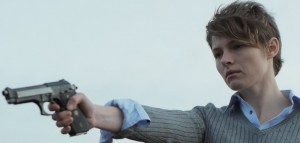 Bend your ear- that sound is the collective sigh of relief from fans of indie science fiction –and fascinating cinema in general– brought on as Shane Carruth’s Upstream Color makes its way into the world. Whether it is good or bad or weird or not is almost incidental- the very fact that it exists turns some valve somewhere and releases an anticipatory pressure building since 2004. It’s some kind of cruel joke that this director’s first film, Primer, not only sat with no follow up for nearly a decade, but did so largely because another fascinating project (that we’ll likely never see) absorbed so many of the filmmaker’s years. I suspect that many fans of the film have, like myself, found themselves living with a quiet, throbbing need to know what else was coming from that mind… The ultra-low-budget, hyper-auteuristc, time-traveling mindfuck that is Primer is a film so singular and so visionary that it’s almost terrifying to consider without more context. Like an optical illusion that jumbles your brain till you can step to the side and see it from a second angle and sort of take hold of it, a single example of Carruth’s vision has been maddeningly inadequate.
Bend your ear- that sound is the collective sigh of relief from fans of indie science fiction –and fascinating cinema in general– brought on as Shane Carruth’s Upstream Color makes its way into the world. Whether it is good or bad or weird or not is almost incidental- the very fact that it exists turns some valve somewhere and releases an anticipatory pressure building since 2004. It’s some kind of cruel joke that this director’s first film, Primer, not only sat with no follow up for nearly a decade, but did so largely because another fascinating project (that we’ll likely never see) absorbed so many of the filmmaker’s years. I suspect that many fans of the film have, like myself, found themselves living with a quiet, throbbing need to know what else was coming from that mind… The ultra-low-budget, hyper-auteuristc, time-traveling mindfuck that is Primer is a film so singular and so visionary that it’s almost terrifying to consider without more context. Like an optical illusion that jumbles your brain till you can step to the side and see it from a second angle and sort of take hold of it, a single example of Carruth’s vision has been maddeningly inadequate.
Now comes Upstream Color, and the algorithmic mindfuck has become an emotional vision, romantic and abstract. It remains as uncompromising.
If you asked a thousand people to, say, decorate a christmas tree with the same few dozen ornaments, you would end up with a thousand unique trees. In that same sense, a thousand people will watch the closing credits of Upstream Color reacting with a thousand different thoughts, feeling a thousand different emotions. In his attempt to explore the concept of human narratives, Carruth has assembled a film that explores identify, spirituality, love and romance, guilt, God, and trauma in a story unlike any you’ve ever seen. Describing specifics or otherwise thematically unpacking the film as I saw it would be to hand you my latest CAT scan and call it a review. I could tell you that I think the film is about the way trauma informs our relationships, how we can either retreat into paranoia or identify the sources of instincts and natures. I can say I think it toys with the way we perceive and store memories and impressions of our world –sounds, textures– and distort  them over time, and what part, if any, a God plays in all that. The trouble and the joy is that I can barely justify those assertions, much less suggest they’re of any value, but there are some things worth clarifying and questions worth me raising by typing out a big block of words.
them over time, and what part, if any, a God plays in all that. The trouble and the joy is that I can barely justify those assertions, much less suggest they’re of any value, but there are some things worth clarifying and questions worth me raising by typing out a big block of words.
First, it’s not injurious to say that Upstream Color is built around a concrete narrative. In fact, the first portion of the film –after setting a textural, exploratory tone and introducing some vaguely scifi plot components– does tell a very specific and linear story of a woman that is put under a terrifyingly simple form of mind-control. We watch what is clearly a systematic and routine exploitation of the woman’s assets and resources, told in a gripping style with sophisticated details. As this setup draws to a close, the film begins weaving in imagery that blurs the line between metaphor and reality- a line that will remain permeable for most of the film. You’ll be forgiven for thinking at times that the film is spinning off into an increasingly ethereal and undecipherable tone poem about relationships, but for those that stay engaged, the waves do break.
Carruth is attempting a very different kind of storytelling here, one that roots grand metaphors in very esoteric details, and allows seemingly allegorical imagery to become concrete plot. Subtext and text affect each other and switch places in ways that I’ll be fucked if I can convincingly describe. It clearly happens though and, like Primer, there’s a sense that if you took pen to paper (or just watched the film half-a-dozen times) you could pretty clearly lay this all out. The mechanisms are altogether weirder than in Carruth’s first film, but they are no less specific.
 It’s rather trite to describe any film that happens to be pretty and cut poetically as “Malick-ian” but it’s a solid comparison here. This is Carruth exploring emotion and memory- the relationship between our conscious selves and the jumbled piles of accumulated experiences buried in our reptilian brains. Dialogue is minimal and fleeting, and though it lacks the dense jargon of his first script, it still carries Carruth’s familiar rhythm. The director once again stars, though the film is largely carried by Amy Semeitz, who is indeed a revelation- there are subtleties to her performance that I’ll still be discovering many viewings from now. There are also the studying looks and ponderous face of Andrew Sensenig in his role that I dare not describe- his character is simply called the “Sampler.”
It’s rather trite to describe any film that happens to be pretty and cut poetically as “Malick-ian” but it’s a solid comparison here. This is Carruth exploring emotion and memory- the relationship between our conscious selves and the jumbled piles of accumulated experiences buried in our reptilian brains. Dialogue is minimal and fleeting, and though it lacks the dense jargon of his first script, it still carries Carruth’s familiar rhythm. The director once again stars, though the film is largely carried by Amy Semeitz, who is indeed a revelation- there are subtleties to her performance that I’ll still be discovering many viewings from now. There are also the studying looks and ponderous face of Andrew Sensenig in his role that I dare not describe- his character is simply called the “Sampler.”
You’ll notice that Upstream Color features a very modern aesthetic, with the hyper-shallow depth of field, miasmas of lightly desatured colors and probing handheld camerawork that we associate with contemporary indie cinema. Naturally though, Carruth has worked hard to add a layer of sophistication to the cinematography and filmmaking. It speaks with the same grammar as familiar post-DSLR indie films, but with far richer prose. The film is a measuredly paced fever-dream of beautiful, stark compositions mixed with hazy close-ups and fascinating macro photography. Organic visual effects breach in from time to time, while the directing and editing work in concert to create powerful visual motifs. The repeated image of people carrying things –boxes, trays, books, bags– subtly accumulates importance as the film unfolds, for example. The sound design is bold and inventive- both a filmmaking tool and an explicit concern of the story. In fact, not to put too fine a point on it, I cannot recall the last time I heard a more dynamic, impactful sound mix.
 None of this is to say that an unmoved member of the audience is a fool- movies of this kind may often leave a viewer more numb than affected. It is a matter of reasonable debate just how far one should have to tread into the depths of obscurity in order to follow a filmmaker’s vision. In the case of Upstream Color though, it’s important to recognize that the path is there if you’re receptive to the wavelength on which it’s being broadcast. The film is not a universal gateway to emotional transcendence, but it’s going to take some viewers to some very memorable places.
None of this is to say that an unmoved member of the audience is a fool- movies of this kind may often leave a viewer more numb than affected. It is a matter of reasonable debate just how far one should have to tread into the depths of obscurity in order to follow a filmmaker’s vision. In the case of Upstream Color though, it’s important to recognize that the path is there if you’re receptive to the wavelength on which it’s being broadcast. The film is not a universal gateway to emotional transcendence, but it’s going to take some viewers to some very memorable places.
Regardless of your reaction, I don’t think it’s controversial to say you have never seen and will never see another film like Upstream Color. That’s an unfortunate thing- there are simply too few films like it being made. We should not have to go to some films to terrify us, others to delight us with beauty, and still more to make us question the nature of romantic pairings. It’s a brave film that paints with so many colors at once, and an important one that doesn’t end up with a portrait of mud as a result. Perhaps it is the sublime one that actually seeks out the mud and roots around in it with the pigs for the answers.
Audio Version (right-click to download):
EMBED